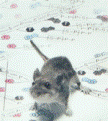Papers in the Biological Sciences

Jay F. Storz Publications
Document Type
Article
Date of this Version
8-2009
Abstract
Adaptive modifications of heteromeric proteins may involve genetically based changes in single subunit polypeptides or parallel changes in multiple genes that encode distinct, interacting subunits. Here we investigate these possibilities by conducting a combined evolutionary and functional analysis of duplicated globin genes in natural populations of deer mice (Peromyscus maniculatus) that are adapted to different elevational zones. A multilocus analysis of nucleotide polymorphism and linkage disequilibrium revealed that high-altitude adaptation of deer mouse hemoglobin involves parallel functional differentiation at multiple unlinked gene duplicates: two α-globin paralogs on chromosome 8 and two β-globin paralogs on chromosome 1. Differences in O2-binding affinity of the alternative β-chain hemoglobin isoforms were entirely attributable to allelic differences in sensitivity to 2,3-diphosphoglycerate (DPG), an allosteric cofactor that stabilizes the low-affinity, deoxygenated conformation of the hemoglobin tetramer. The two-locus β-globin haplotype that predominates at high altitude is associated with suppressed DPGsensitivity (and hence, increased hemoglobin-O2 affinity), which enhances pulmonary O2 loading under hypoxia. The discovery that allelic differences in DPG-sensitivity contribute to adaptive variation in hemoglobin– O2 affinity illustrates the value of integrating evolutionary analyses of sequence variation with mechanistic appraisals of protein function. Investigation into the functional significance of the deer mouse β-globin polymorphism was motivated by the results of population genetic analyses which revealed evidence for a history of divergent selection between elevational zones. The experimental measures of O2-binding properties corroborated the tests of selection by demonstrating a functional difference between the products of alternative alleles.


Comments
Published in Proceedings of the National Academy of Sciences USA 106:34 (August 25, 2009), pp. 14450-14455; doi: 10.1073/pnas.0905224106. Copyright 2009 National Academy of Sciences USA. Used by permission.